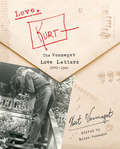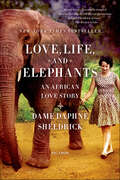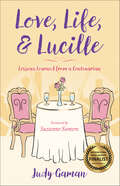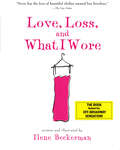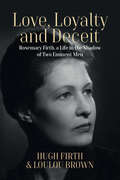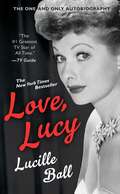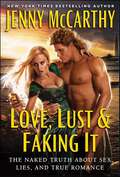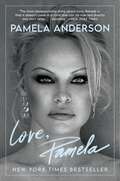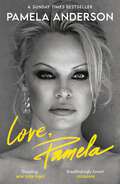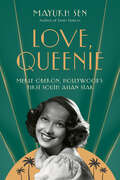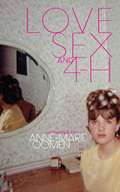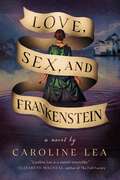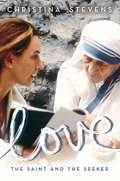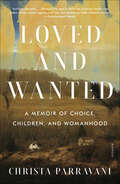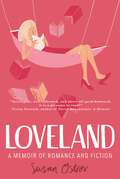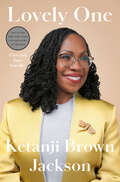- Table View
- List View
Love, Kurt: The Vonnegut Love Letters, 1941-1945
by Kurt VonnegutA never-before-seen collection of deeply personal love letters from Kurt Vonnegut to his first wife, Jane, compiled and edited by their daughter&“If ever I do write anything of length—good or bad—it will be written with you in mind.&”Kurt Vonnegut&’s eldest daughter, Edith, was cleaning out her mother&’s attic when she stumbled upon a dusty, aged box. Inside, she discovered an unexpected treasure: more than two hundred love letters written by Kurt to Jane, spanning the early years of their relationship.The letters begin in 1941, after the former schoolmates reunited at age nineteen, sparked a passionate summer romance, and promised to keep in touch when they headed off to their respective colleges. And they did, through Jane&’s conscientious studying and Kurt&’s struggle to pass chemistry. The letters continue after Kurt dropped out and enlisted in the army in 1943, while Jane in turn graduated and worked for the Office of Strategic Services in Washington, D.C. They also detail Kurt&’s deployment to Europe in 1944, where he was taken prisoner of war and declared missing in action, and his eventual safe return home and the couple&’s marriage in 1945.Full of the humor and wit that we have come to associate with Kurt Vonnegut, the letters also reveal little-known private corners of his mind. Passionate and tender, they form an illuminating portrait of a young soldier&’s life in World War II as he attempts to come to grips with love and mortality. And they bring to light the origins of Vonnegut the writer, when Jane was the only person who believed in and supported him supported him, the young couple having no idea how celebrated he would become.A beautiful full-color collection of handwritten letters, notes, sketches, and comics, interspersed with Edith&’s insights and family memories, Love, Kurt is an intimate record of a young man growing into himself, a fascinating account of a writer finding his voice, and a moving testament to the life-altering experience of falling in love.
Love, Life, and Elephants: An African Love Story
by Daphne Sheldrick“Enchanting . . . Sheldrick and her pioneering game warden husband David have often been ahead of science in their understanding of African wildlife.” —The Daily Telegraph (London)Daphne Sheldrick, whose family arrived in Africa from Scotland in the 1820s, is the first person ever to have successfully hand-reared newborn elephants. Her pioneering work in perfecting the right husbandry and milk formula have saved countless elephants, rhinos, and other baby animals from certain death.In this heartwarming and poignant memoir, Daphne shares her amazing relationships with a host of orphans, including her first love, Bushy, a liquid-eyed antelope; Rickey-Tickey-Tavey, the little dwarf mongoose; Gregory Peck, the busy buffalo weaver bird; Huppety, the mischievous zebra; and the majestic elephant Eleanor, with whom Daphne has shared more than forty years of great friendship.But this is also a magical and heartbreaking human love story between Daphne and David Sheldrick, the famous Tsavo Park warden. It was their deep and passionate love, David’s extraordinary insight into all aspects of nature, and the tragedy of his early death that inspired Daphne’s vast array of achievements, most notably the founding of the world-renowned David Sheldrick Wildlife Trust and the Orphans’ Nursery in Nairobi National Park, where Daphne continues to live and work to this day.Encompassing not only David and Daphne’s tireless campaign for an end to poaching and for conserving Kenya’s wildlife, but also their ability to engage with the human side of animals and their rearing of the orphans expressly so they can return to the wild, Love, Life, and Elephants is alive with compassion and humor, providing a rare insight into the life of one of the world’s most remarkable women.
Love, Life, and Lucille: Lessons Learned from a Centenarian
by Judy GamanJudy Gaman was so busy making a name for herself that she barely took the time to meet a stranger, enjoy life, or simply stop to breathe. Immersed in her job as the director of business development for a high-profile medical practice—a job that required her to write health and wellness books and host a nationally syndicated radio show—she spent every day going full speed ahead with no looking back. That is, until the day she met Lucille Fleming. While writing a book on longevity, Judy interviewed Lucille, an elegant and spirited woman who had just recently turned 100. Lucille had the fashion and style of old Hollywood, but it was all hidden behind the doors of her assisted living center. What began as a quick meeting became a lasting friendship that transformed into an inseparable bond. Lucille brought incredible wisdom and great stories to the table, while Judy provided an avenue for excitement and new opportunities. Together, the two began living life to the fullest, and meeting the most interesting people along the way (including Suzanne Somers). But then Lucille’s life came to an end through unexpected and unfortunate circumstances—and the very first lesson she ever taught Judy proved to be the most important one of all.
Love, Loosha: The Letters of Lucia Berlin and Kenward Elmslie
by Lucia Berlin Kenward ElmslieAt the time of her death in 2004, Lucia Berlin was known as a brilliant writer of short stories, beloved by other writers but never achieving wide readership or acclaim. That changed in 2015 with the publication of A Manual for Cleaning Women, a collection of some of her best work. Almost overnight, Lucia Berlin became an international bestseller.Love, Loosha is the extraordinary collection of letters between Lucia Berlin and her dear friend, the poet and Broadway lyricist Kenward Elmslie. Written between 1994 and 2004, their correspondence reveals the lives, work, and literary obsessions of two great American writers. Berlin and Elmslie discuss publishing and social trends, political correctness, and offending others and being offended. They gossip. They dish. They entertain.Love, Loosha is an intimate conversation between two friends—one in which we are invited to participate, and one that will give fans of Lucia Berlin and Kenward Elmslie much pleasure and fresh insight into their lives and work.
Love, Loss, and What I Wore
by Ilene BeckermanIlene "Gingy" Beckerman's beloved and bestselling book has been adapted for the stage by Nora and Delia Ephron. The star-studded Off-Broadway show is receiving rave reviews, as did the book: “Illuminates the experience of an entire generation of women. . . . This small gem of a book is worthy of a Tiffany box.” — The New York Times Book Review “A memoir every reader will wish to copy in her own size.” —Glamour “Ilene Beckerman’s sleek little memoir . . . strikes a startling chord. . . . Unsettling and oddly powerful.” —People “Surprisingly poetic.” —Entertainment Weekly “[A] poignant biography. . . . This little book will charm anyone with an interest in style.” —USA Today Ilene Beckerman’s runaway bestseller articulates something all women know: that our memories are often tied to our favorite clothes. From her Brownie uniform to her Pucci knockoff to her black strapless Rita Hayworth–style dress from the Neiman Marcus outlet store, Ilene Beckerman tells us the story of her life.
Love, Loss, and What We Ate: A Memoir
by Padma LakshmiLong before Padma Lakshmi ever stepped onto a television set, she learned that how we eat is an extension of how we love, how we comfort, how we forge a sense of home—and how we taste the world as we navigate our way through it. Shuttling between continents as a child, she lived a life of dislocation that would become habit as an adult, never quite at home in the world. And yet, through all her travels, her favorite food remained the simple rice she first ate sitting on the cool floor of her grandmother’s kitchen in South India. <p><p> Poignant and surprising, Love, Loss, and What We Ate is Lakshmi’s extraordinary account of her journey from that humble kitchen, ruled by ferocious and unforgettable women, to the judges’ table of Top Chef and beyond. It chronicles the fierce devotion of the remarkable people who shaped her along the way, from her headstrong mother who flouted conservative Indian convention to make a life in New York, to her Brahmin grandfather—a brilliant engineer with an irrepressible sweet tooth—to the man seemingly wrong for her in every way who proved to be her truest ally. A memoir rich with sensual prose and punctuated with evocative recipes, it is alive with the scents, tastes, and textures of a life that spans complex geographies both internal and external. <p> Love, Loss, and What We Ate is an intimate and unexpected story of food and family—both the ones we are born to and the ones we create—and their enduring legacies.
Love, Loyalty and Deceit: Rosemary Firth, a Life in the Shadow of Two Eminent Men
by Hugh Firth Loulou BrownHow much do we really know about our parents’ lives? What secrets lie in plain sight? This is the true story of hidden love within a small circle of some of the most acclaimed anthropologists of the 20th century. Told by Rosemary and Raymond Firth's son, and the daughter of Celia and Edmund Leach, the man Rosemary loved all her life, this part love-story, part biography, part social history is the tale of a highly influential circle of social anthropologists in Britain from the 1930s, through the Second World War, to the end of the century. The book explores their early influences, their insecurities, their flaws, struggles and achievements. It is a story of passion and commitment, but also of deceit and betrayal, including the inexplicable disappearance, death and alleged murder of a very close friend. It also narrates Rosemary's struggles for emotional and intellectual independence in the face of societal expectations of women and her own guilt, loss and self-doubt. From the Prologue: Rosemary loved many people in many different ways, but she loved two men in particular throughout most of her life. One was her husband, Raymond Firth, regarded by some as among the founding fathers of social anthropology. Yet she also retained a passionate devotion to her first love, Edmund Leach, who would subsequently become the public intellectual face of social anthropology in the later 1960s. Both separately and together they were part of the process of defining the nature of this still growing discipline in the first part of the mid-twentieth century.
Love, Lucy
by Lucille BallTHE NEW YORK TIMES BESTSELLERThe one and only autobiography by the iconic Lucille Ball, hailed by TV Guide as the “#1 Greatest TV Star of All Time.”Love, Lucy is the valentine Lucille Ball left for her fans—a warm, wise, and witty memoir written by Lucy herself. The legendary star of the classic sitcom I Love Lucy was at the pinnacle of her success when she sat down to record the story of her life. No comedienne had made America laugh so hard, no television actress had made the leap from radio and B movies to become one of the world's best-loved performers. This is her story—in her own words.The story of the ingenue from Jamestown, New York, determined to go to Broadway, destined to make a big splash, bound to marry her Valentino, Desi Arnaz. In her own inimitable style, she tells of their life together—both storybook and turbulent; intimate memories of their children and friends; wonderful backstage anecdotes; the empire they founded; the dissolution of their marriage. And, with a heartfelt happy ending, her enduring marriage to Gary Morton.Here is the lost manuscript that her fans and loved ones will treasure. Here is the laughter. Here is the life. Here’s Lucy...“The comic actress in her own words...intensley moving.”—San Francisco Chronicle“Filled with light and laughter.”—New York Times Book Review
Love, Lust & Faking It: The Naked Truth About Sex, Lies, and True Romance
by Jenny McCarthy"Even though this book is not as funny as mine, you should still buy it." —Chelsea HandlerNew York Times bestselling author Jenny McCarthy turns on the lights for a bawdy and hilarious look at women and sex. Returning to her comic roots and the tell-all tone that readers loved in Baby Laughs and Belly Laughs, this exposé from the former Playboy Bunny, MTV star, and prime-time TV sensation is perfect for fans of Sarah Silverman's Bedwetter and Chelsea Handler's Are You There Vodka? It's Me, Chelsea. Delivering the perfect mix of poignant insights, laugh-out-loud confessions, and spicy secrets, Love, Lust & Faking It will be an instant favorite…but it may find its way to your nightstand instead of your bookcase.
Love, Mom: Inspiring Stories Celebrating Motherhood
by Nicole SaphierFrom Fox News medical contributor Dr. Nicole Saphier, comes an inspiring collection of powerful first-person stories celebrating motherhood, from Fox News personalities and extraordinary moms around America. <P><P> Unmatched and unwavering, mothers are the embodiment of selfless, pure, and unconditional love. But so often, the sacrifices and triumphs of motherhood go unrecognized. Now, in Love, Mom, Fox News medical contributor and mom of three, Dr. Nicole Saphier, shines a light on the power of a mother’s love, with inspiring first-person stories from moms in the Fox News family. <P><P> For Dr. Saphier—who was just a teenager when she gave birth to her first son—motherhood was a transformative responsibility. Her story, like so many moms featured in this book, is an inspiration for what it means to be there for your child, no matter where you are in life. Alongside Dr. Saphier’s account are deeply personal contributions from FOX News anchors and personalities, such as: <P><P> Ainsley Earhardt, on the precious bond between mother and daughter, the loss of her own mom, and the power of her faith. <P><P>Rachel Campos-Duffy, on raising nine children, unexpected blessings, and dedicating her life to advocating for education and awareness about children with Down Syndrome. <P><P>Kayleigh McEnany, on embracing motherhood despite health challenges, and the delicate balance between career aspirations and the profound gift of raising children. <P><P>Janice Dean, on navigating the heartbreak of miscarriage, living with an autoimmune disease, and finding joy in raising boys. <P><P>Martha MacCallum, on the challenges of juggling career and family, the myth of perfection, and the importance of being kind to yourself. <P><P>Sandra Smith, on how motherhood truly takes a village, and the value of a strong support system as a working mom. <P><P>Carley Shimkus, on being a new mom, and balancing new responsibilities with grace and determination. <P><P>In Love, Mom, these mothers share their powerful stories, greatest challenges, and insightful reflections about young motherhood, miscarriage, ovarian cancer, mixed race children, postpartum depression, domestic violence, adoption, blended families, and more. Ultimately, Love, Mom is a celebration of motherhood and reminds us that a mother’s strength and love is an extraordinary gift. <p> <b>New York Times Bestseller</b>
Love, Nina: A Nanny Writes Home
by Nina Stibbe"Breezy, sophisticated, hilarious, rude and aching with sweetness: LOVE, NINA might be the most charming book I've ever read." --Maria Semple, author of Where'd You Go, BernadetteIn 1982, 20-year-old Nina Stibbe moved to London to work as a nanny to two opinionated and lively young boys. In frequent letters home to her sister, Nina described her trials and triumphs: there's a cat nobody likes, suppertime visits from a famous local playwright, a mysteriously unpaid milk bill, and repeated misadventures parking the family car. Dinner table discussions cover the gamut, from the greats of English literature, to swearing in German, to sexually transmitted diseases. There's no end to what Nina can learn from these boys (rude words) and their broad-minded mother (the who's who of literary London).A charming, hilarious, sweetly inspiring celebration of bad food and good company, Love, Nina makes a young woman's adventures in a new world come alive. makes a young woman's adventures in a new world come alive.
Love, Pamela: A Memoir
by Pamela AndersonThe actress, activist, and once infamous Playboy Playmate reclaims the narrative of her life in a memoir that defies expectation in both content and approach, blending searing prose with snippets of original poetry.In this honest, layered and unforgettable book that alternates between storytelling and her own poetry, Pamela Anderson breaks the mold of the celebrity memoir while taking back the tale that has been crafted about her.Her blond bombshell image was ubiquitous in the 1990s. Discovered in the stands of a football game, she was immediately rocket launched into fame, becoming Playboy’s favorite cover girl and an emblem of Hollywood glamour and sexuality. But what happens when you lose grip on your own life—and the image the notoriety machine creates for you is not who you really are?Growing up on Vancouver Island, the daughter of young, wild, and unprepared parents, Pamela Anderson’s childhood was not easy, but it allowed her to create her own world—surrounded by nature and imaginary friends. When she overcame her deep shyness and grew into herself, she fell into a life on the cover of magazines, the beaches of Malibu, the sets of movies and talk shows, the arms of rockstars, the coveted scene at the Playboy Mansion. And as her star rose, she found herself tabloid fodder, at the height of an era when paparazzi tactics were bent on capturing a celebrity’s most intimate, and sometimes weakest moments. This is when Pamela Anderson lost control of her own narrative, hurt by the media and fearful of the public’s perception of who she was…and who she wasn’t.Fighting back with a sense of grace, fueled by a love of art and literature, and driven by a devotion to her children and the causes she cares about most, Pamela Anderson has now gone back to the island where she grew up, after a memorable run starring as Roxie in Chicago on Broadway, reclaiming her free spirit but also standing firm as a strong, creative, confident woman.
Love, Pamela: Her new memoir, taking control of her own narrative for the first time
by Pamela AndersonACTRESS. ICON. ACTIVIST. Her story, in her voice, for the first time. In this honest, layered and unforgettable book that alternates between storytelling and her own poetry, Pamela Anderson breaks the mould of the celebrity memoir while taking back the tale that has been crafted about her.Her blond bombshell image was ubiquitous in the 1990s. Discovered in the stands of a football game, she was immediately rocket launched into fame, becoming Playboy's favourite cover girl and an emblem of Hollywood glamour and sexuality. But what happens when you lose grip on your own life - and the image the notoriety machine creates for you is not who you really are?Growing up on Vancouver Island, the daughter of young, wild, and unprepared parents, Pamela Anderson's childhood was not easy, but it allowed her to create her own world-surrounded by nature and imaginary friends. When she overcame her deep shyness and grew into herself, she fell into a life on the cover of magazines, the beaches of Malibu, the sets of movies and talk shows, the arms of rockstars, the coveted scene at the Playboy Mansion. And as her star rose, she found herself tabloid fodder, at the height of an era when paparazzi tactics were bent on capturing a celebrity's most intimate, and sometimes weakest moments. This is when Pamela Anderson lost control of her own narrative, hurt by the media and fearful of the public's perception of who she was . . . and who she wasn't.Fighting back with a sense of grace, fuelled by a love of art and literature, and driven by a devotion to her children and the causes she cares about most, Pamela Anderson has now gone back to the island where she grew up, after a memorable run starring as Roxie in Chicago on Broadway, reclaiming her free spirit but also standing firm as a strong, creative, confident woman. 'The iconic Anderson uses a mixture of poetry and prose to present an impressionistic view of a fascinating life' Booklist
Love, Queenie: Merle Oberon, Hollywood's First South Asian Star
by Mayukh SenA Kirkus Most Anticipated Nonfiction Book A beautiful reclamation of a pioneering South Asian actress captures her glittering, complicated life and lasting impact on Hollywood. Merle Oberon made history when she was announced as a nominee for the Best Actress Oscar in 1936. Hers was a face that “launched a thousand ships,” a so-called exotic beauty who the camera loved and fans adored. Her nomination for The Dark Angel marked the first time the Academy recognized a performer of color. Almost ninety years before actress Michelle Yeoh would triumph in the same category, Oberon, born to a South Asian mother and white father in India, broke through a racial barrier—but no one knew it. Oberon was “passing” for white. In the first biography of Oberon (1911–1979) in more than forty years, Mayukh Sen draws on family interviews and heretofore untapped archival material to capture the exceptional life of an oft-forgotten talent. Born into poverty, Queenie Thompson dreamt of big-screen stardom. By sheer force of will, she immigrated to London in her teens and met film mogul Alexander Korda, who christened her “Merle Oberon” and invented the story that she was born to European parents in Tasmania. Her new identity was her ticket into Hollywood. When she was only in her twenties, Oberon dazzled as Cathy in Wuthering Heights opposite Laurence Olivier. Against the backdrop of Hollywood’s racially exclusionary Golden Age and the United States’s hostile immigration policy towards South Asians in the twentieth century, Oberon rose to the highest echelons of the film-world elite, all while keeping a secret that could have destroyed her career. Tracing Oberon’s story from her Indian roots to her final days surrounded by wealth and glamor, Sen questions the demands placed on stars in life and death. His compassionate, compelling chronicle illuminates troubling truths on race, gender, and power that still resonate today.
Love, Rita: An American Story of Sisterhood, Joy, Loss, and Legacy
by Bridgett M. DavisA searing tribute of sisterhood and family, profound love and loss from the acclaimed author of The World According to Fannie Davis.In Love, Rita Bridgett M. Davis tells the story of her beloved older sister Rita, who knew Bridgett before she knew herself. Just four years apart in age, as the two sisters grew into young adulthood they left behind their childhood rivalry and became best friends.Rita was a vivacious woman who attended Fisk University at age sixteen, and went on to become a car test driver, an amateur belly dancer, an MBA, and later a popular special ed teacher; in doing so, she modeled for her younger sister Bridgett how to live boldly. And in the face of family tragedy, the two sisters leaned on each other to heal; their closeness grew, until Rita’s life was cut short by lupus when she was forty-four. This led Bridgett to ask the simple, heartbreaking question: Why Rita? Love, Rita is a brave and beautiful homage that not only celebrates the special, complex bond of sisterhood but also reveals what it is to live, and die, as a Black woman in America.This moving memoir, full of joy and heartbreak, family history alongside American history, uses Rita’s life as a lens to examine the persistent effects of racism in the lives of Black women—and the men they love. This poignant, deeply resonant portrait of an unforgettable woman and her impact on those she left behind is essential reading.
Love, Sex, and 4-H (Made in Michigan Writers Series)
by Anne-Marie OomenAs the 1960s dawned in small-town Michigan, Anne-Marie Oomen was a naive farm girl whose mother was determined to keep her out of trouble--by keeping her in 4-H. In Love, Sex, and 4-H, Oomen sets the wholesomeness of her domestic lessons in 4-H club from 1959 to 1969 against the political and sexual revolution of the time. Between sewing her first dish towel and finishing the yellow dress she wears to senior prom, Oomen brings readers along as she falls in and out of love, wins her first prize, learns to kiss, survives her first heartbreak, and makes almost all of her clothes. Love, Sex, and 4-H begins as Oomen struggles to sew a straight seam and works hard to embody the 4-H pledge of loyalty, service, and better living. But even as she wins her first modeling competition and masters more difficult stitches and patterns, Oomen finds that she is not immune to the chaos of the outside world. After the Kennedy assassination, the Cuban Missile Crisis, and her own short stay in a convent, Oomen encounters the biggest change of all--public school. In this new world of school dances, short skirts, and raging hormones, Oomen's orderly life will be complicated by her first kiss, first boyfriend, first store-bought dress, and finally, first love. All the while, she must negotiate her mother's expectations, her identity as a good 4-H girl, and her awareness of growing social and political unrest. Oomen brings an insightful and humorous eye to her evolving sexuality, religious beliefs, and sense of self. Fans of memoir will appreciate the honest portrayal of growing up between rebellion and tradition in Love, Sex, and 4-H.
Love, Sex, and Frankenstein: A Novel
by Caroline LeaAn evocative, haunting retelling of the summer that should have broken Mary Shelley, but instead inspired her to write her masterpiece.Villa Diodati, Lake Geneva, 1816: the dark summer that birthed a monster. Eighteen-year-old Mary Shelley has fled London with her lover, Percy Shelley, and her sister, Claire. Tormented by Shelley&’s betrayals, haunted by the loss of their baby, and suspicious of her sister&’s intentions, Mary seeks a refuge. But Lord Byron&’s villa, lying under ominous, ash-shrouded skies, feels more like a trap. When Byron suggests each guest write a supernatural tale, Mary is as drawn to the challenge as she is, unexpectedly, to Byron himself. And so an idea begins to form in her mind . . . It spills out of her in thick, black ink. A thing given life by her imagination. Day and night, it possesses her. Her heart, her desires. But is she in control, or is it? In this hauntingly evocative feminist retelling, Caroline Lea delves into the female rage, creative madness and steamy scandal that bore the world's most famous work of gothic fiction.
Love, Tanya
by Tanya BurrLove, Tanya is the first book from YouTube sensation Tanya Burr.Hi everyone and welcome to Love, Tanya! This book is really close to my heart, because it's inspired by my journey to becoming confident and feeling happy about who I am. I wanted to write a book to share the things I've learnt with you - to reveal my top tips on fashion, beauty, love, friendship, YouTube... and loads more! Plus, there is room for you to list your own hopes and dreams alongside mine - so get creative and get involved! I'd love it if this book became a keepsake you can turn to whenever you need some guidance or a little pick me up. I hope you enjoy it!Love, Tanya
Love, Teach: Real Stories and Honest Advice to Keep Teachers from Crying Under Their Desks
by Kelly TreleavenHopeful, hilarious musings and serious advice for new teachers from the formerly anonymous blogger behind Love, Teach.Every teacher will tell you the first years are the hardest, and even the most confident of the pack sometimes ask themselves, Am I cut out for this? Kelly Treleaven, the teacher and once-anonymous blogger behind Love, Teach, wants you to know that you're not alone, and that yes, she has cried under her desk, too. Treleaven's blog has become a sensation in the education world, known for its heartfelt, high-spirited dispatches straight from the trenches and its practical advice.In Treleaven's debut book, she gives rookie teachers the advice she wishes she'd had when she started out in a large district in Houston. From logistical questions like how to prep and organize a classroom, to deeper issues like how to build relationships with students, navigate administration, and avoid burnout, Love, Teach is an essential book for anyone working in education today or considering the profession. With raw feeling, humor, and a razor-sharp perspective, Love, Teach supports teachers in their fight for a better future, and helps them celebrate the victories, large and small.
Love: The Saint And The Seeker
by Christina Stevens"God will write through you." Those were almost the last private words Mother Teresa spoke to acclaimed filmmaker Christina Stevens ~ urging her to share her story with the world. A similar calling had come months earlier, when Mother Teresa appeared to Christina in a dream, summoning her to India to film her message to the world. Without hesitation, she gathered a film crew and boarded a plane for Calcutta.Little did she know that when destiny beckons and a Saint-to-be takes your hand, startling events and profound discoveries are around every corner. Told through the lens of Christina’s colorful youth, her mind-expanding adventure may prod you to recognize your own life’s calling, and that will lead you to the most powerful and transformative place in the cosmos ~ love.
Loved Back to Life: How I Found the Courage to Live Free
by Sheila WalshJoin Sheila Walsh on her journey from despair to joy Beautiful and talented, Sheila Walsh was at the pinnacle of her career, appearing daily on television as cohost of The 700 Club. One day she found herself walking away from it all and checking in to a psychiatric hospital, where she stayed for a month. From the outside everything seemed fine, but on the inside Sheila was in trouble. In her journal she wrote, "Lord, please hold me. I'm falling into a dark well. I feel as if I am disappearing a little more every day. I am so angry inside that I am afraid of myself. I feel so alone." How did this happen? What brought her to her knees? Loved Back to Life takes readers on Sheila's journey of the soul from hopelessness to joy as she finds that although the road was scary, at every turn God beckoned her to follow and trust Him. And He did not let her down.
Loved and Wanted: A Memoir of Choice, Children, and Womanhood
by Christa Parravani"Haunting, wild, and quiet at once. A shimmering look at motherhood, in all its gothic pain and glory. I could not stop reading." —Lisa Taddeo, #1 New York Times bestselling author of Three WomenA stressed family, an unplanned pregnancy, and a painful, if liberating, awakening from the author of the lauded memoir HerChrista Parravani was forty years old, in a troubled marriage, and in bad financial straits when she learned she was pregnant with her third child. She and her family were living in Morgantown, West Virginia, where she had taken a professorial position at the local university.Haunted by a childhood steeped in poverty and violence and by young adult years rocked by the tragic death of her identical twin sister, Christa hoped her professor’s salary and health care might set her and her young family on a safe and steady path. Instead, one year after the birth of her second child, Christa found herself pregnant again. Six weeks into the pregnancy, she requested an abortion. And in the weeks, then months, that followed, nurses obfuscated and doctors refused outright or feared being found out to the point of, ultimately, becoming unavailable to provide Christa with reproductive choice.By the time Christa understood that she would need to leave West Virginia to obtain a safe, legal abortion, she’d run out of time. She had failed to imagine that she might not have access to reproductive choice in the United States, until it was too late for her, her pregnancy too far along.So she gave birth to a beautiful baby boy named Keats. And another frightening education began: available healthcare was dangerously inadequate to her newborn son’s needs; indeed, environmental degradations and poor healthcare endangered Christa’s older children as well.Loved and Wanted is the passionate story of a woman’s love for her children, and a poignant and bracing look at the difficult choices women in America are forced to make every day, in a nation where policies and a cultural war on women leave them without sufficient agency over their bodies, their futures, and even their hopes for their children’s lives.
Lovejoy on Football: One Man's Passion for The Most Important Subject in the World
by Tim LovejoyTim Lovejoy loves football. Along with Helen Chamberlain he presented Soccer AM for more than a decade to become as much a part of a football fan's weekend as phone-ins, back-page EXCLUSIVES and the vidiprinter. But why does Tim love football? Is it actually the most important subject in the world? And did he really once support Watford as a kid?Lovejoy on Football gets down to the nitty gritty of the really important stuff in football, such as:Why he, Tim, is technically a rubbish football fan; Women's true place in football;How 'Save Chip' became the biggest football cause in the country;Why it's a bad idea to hammer Razor Ruddock; And why footballers are in fact underpaid.Packed with amusing anecdotes, bustling with great football stories and full of strong opinions, Lovejoy on Football is the must-have football book of 2007.
Loveland: A Memoir of Romance and Fiction
by Susan OstrovThis is not your usual memoir – much less a typical love story.Loveland is about the unfolding of unmet expectations, of shattered childhood dreams, of tenderness found unexpectedly; it is the uncovering of different layers of one' s self, relationship after relationship.The rationale for understanding the engineering of love, in its infinite nuances, comes through the framework of literature. Books shape our perceptions: their characters set parameters, their stories create paradigms, and we live by them forever.If you' re interested in a different vision of happily-ever-after, this is the book for you.
Lovely One: A Memoir
by Ketanji Brown Jackson#1 NEW YORK TIMES BESTSELLER • In her &“vulnerable, tender, and infinitely inspirational&” (Oprah Daily) memoir, the first Black woman to ever be appointed to the Supreme Court of the United States chronicles her extraordinary life story. &“A billowingly triumphant American tale.&”—The New York Times Book Review (Editors&’ Choice)A NEW YORK TIMES BOOK REVIEW AND NEW YORKER BEST BOOK OF THE YEARWith this unflinching account, Justice Ketanji Brown Jackson invites readers into her life and world, tracing her family&’s ascent from segregation to her confirmation on America&’s highest court within the span of one generation. Named &“Ketanji Onyika,&” meaning &“Lovely One,&” based on a suggestion from her aunt, a Peace Corps worker stationed in West Africa, Justice Jackson learned from her educator parents to take pride in her heritage since birth. She describes her resolve as a young girl to honor this legacy and realize her dreams: from hearing stories of her grandparents and parents breaking barriers in the segregated South, to honing her voice in high school as an oratory champion and student body president, to graduating magna cum laude from Harvard, where she performed in musical theater and improv and participated in pivotal student organizations. Here, Justice Jackson pulls back the curtain, marrying the public record of her life with what is less known. She reveals what it takes to advance in the legal profession when most people in power don&’t look like you, and to reconcile a demanding career with the joys and sacrifices of marriage and motherhood. Through trials and triumphs, Justice Jackson&’s journey will resonate with dreamers everywhere, especially those who nourish outsized ambitions and refuse to be turned aside. This moving, openhearted tale will spread hope for a more just world, for generations to come.
